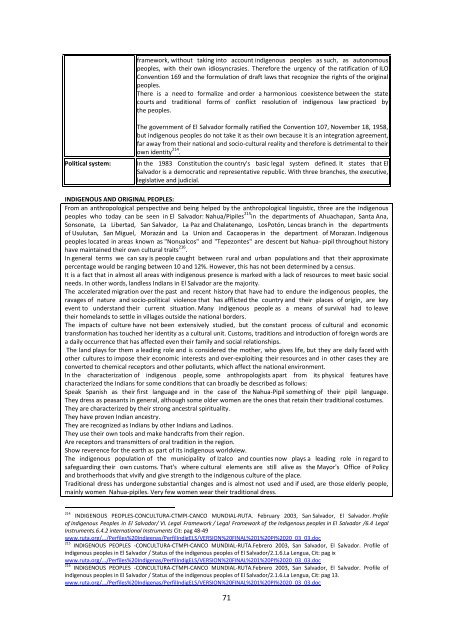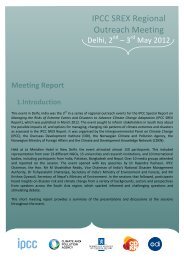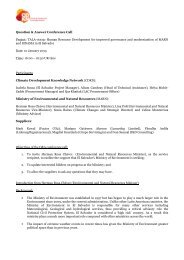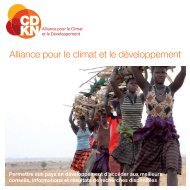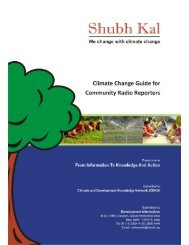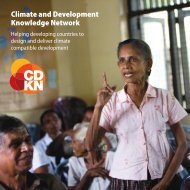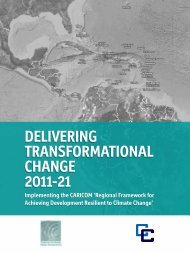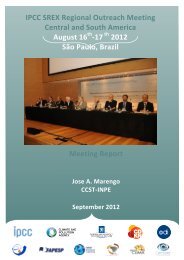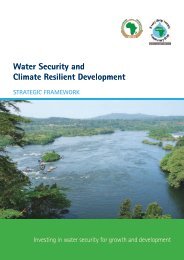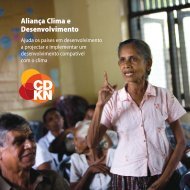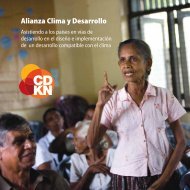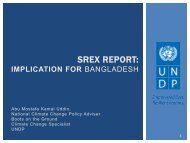ANNEX IVIndigenous Peoples in El SalvadorCOUNTRY DATA:209Capital:Surface:Geography: 210Population:Indigenous Population:San SalvadorThe extension of its territory is 21.393 Km2.El Salvador is the smallest country in Central America. Its limits are: to the west andnorthwest by Guatemala, north and northwest by Honduras and south and southeast bythe Pacific Ocean. Southeast also limits with Nicaragua through the Gulf of Fonseca, whichbelongs in common to Honduras, El Salvador and Nicaragua.The population of El Salvador is 5,744,113 (2007census) within its territory. It is estimatedthat the ethnic composition is comprised of 90% of mixed race, 9% White andamerindian, of which very few have retained their customs and traditions. It is the mostdensely populated country in Latin America.Not recorded in the national census breakdown by ethnicity or indigenous / nativepeoplesLegal recognition of In El Salvador there is no specific legal framework that recognizes the existence andindigenous peoples: 211 protects the rights of indigenous peoples. In Article 62 of the Constitution of El Salvador,in paragraph II, says: "The indigenous languages that are spoken within the nationalterritory are part of the cultural heritage and shall be preserved, disseminated andrespected" and in Art. 63, says: "The rich artistic, historical, and archaeological country arepart of the cultural treasure of El Salvador, which is under the protection of the State andsubject to special laws for their conservation".IDH Of 0.747213Internationalconventions signed withindigenous peoples bythe country:When the Constitution refers to these items, we ignore the human component, theexistence and recognition of indigenous peoples, looking like folkloric and patrimonialobjectsNot recognizing the autonomy and other rights of these peoples is only done from thestandpoint of folklore. For historical, social, cultural and political purposes, they areinvisibilized, making it necessary to draft national laws to protect and recognize theircustomary rights as well as the constitutional recognition of their existence as peoples.For its part, CONCULTURA has made several actions in relation to the strengtheningand recovery of the Nahuat language but unrelated to the formal education system. Withregard to Article 63, the bodies responsible for CONCULTURA and in this case, theNational Directorate of Cultural Heritage, has enacted the Law of Cultural Heritage,focusing its main attention to the ancestral heritage, but not to improve the livingconditions the heirs of these ancient treasures212, it has not been linked their work tothe indigenous communities in rescue, preservation and dissemination actions as itseems they are more interested in the built heritage that in the culture that is alive.The Government of El Salvador on Convention 107, made a series of sociological andpolitical considerations, in order to describe the legal status of indigenous communities inthe country and to identify organizations that make it up, offering also the indexcompliance with the obligations of the Government in consequence of the Convention.As can be seen, there are aspects of non-legislated discrimination, but in a general209 Wikipedia-El Salvador: http://es.wikipedia.org/wiki/El_Salvador210 EL SALVADOR, DE LA ESPERANZA A LA DESILUSIÓN.PARTE I. ADMINISTRATIVE AND GEOGRAPHICAL DATA By Heródoto el Rojo:http://www.nodo50.org/arevolucionaria/masarticulos/junio2004/salvador1.htm211INDIGENOUS PEOPLES-CONCULTURA-CTMPI-CANCO MUNDIAL-RUTA. February 2003, San Salvador, El Salvador. Profileof indigenous Peoples in El Salvador/ VI. Legal Framework / Legal Framework of the Indigenous peoples in El Salvador/ 6.4LegalInstruments.6.4.1 National Instruments, Cit: Pag 52:www.ruta.org/.../Perfiles%20Indigenas/PerfilIndigELS/VERSION%20FINAL%201%20PI%2020_03_03.doc212 CONCULTURA, has a Special Law for the Protection of Cultural Heritage of El Salvador, which are reported as assets thatcomprise the cultural heritage, ethnological material, of historic, vernacular and ethnographic language Nahuatl and otherindigenous and the traditions and customs, techniques and traditional craft products. See, Article 3 paragraphs f,ñ-l y 2.213 2007 Data. http://es.wikipedia.org/wiki/Anexo:Pa%C3%ADses_por_%C3%ADndice_de_desarrollo_humano70
framework, without taking into account indigenous peoples as such, as autonomouspeoples, with their own idiosyncrasies. Therefore the urgency of the ratification of ILOConvention 169 and the formulation of draft laws that recognize the rights of the originalpeoples.There is a need to formalize and order a harmonious coexistence between the statecourts and traditional forms of conflict resolution of indigenous law practiced bythe peoples.Political system:The government of El Salvador formally ratified the Convention 107, November 18, 1958,but indigenous peoples do not take it as their own because it is an integration agreement,far away from their national and socio-cultural reality and therefore is detrimental to theirown identity 214 .In the 1983 Constitution the country's basic legal system defined. It states that ElSalvador is a democratic and representative republic. With three branches, the executive,legislative and judicial.INDIGENOUS AND ORIGINAL PEOPLES:From an anthropological perspective and being helped by the anthropological linguistic, three are the indigenouspeoples who today can be seen in El Salvador: Nahua/Pipiles 215 in the departments of Ahuachapan, Santa Ana,Sonsonate, La Libertad, San Salvador, La Paz and Chalatenango, LosPotón, Lencas branch in the departmentsof Usulutan, San Miguel, Morazán and La Union and Cacaoperas in the department of Morazan. Indigenouspeoples located in areas known as "Nonualcos" and "Tepezontes" are descent but Nahua- pipil throughout historyhave maintained their own cultural traits 216 .In general terms we can say is people caught between rural and urban populations and that their approximatepercentage would be ranging between 10 and 12%. However, this has not been determined by a census.It is a fact that in almost all areas with indigenous presence is marked with a lack of resources to meet basic socialneeds. In other words, landless Indians in El Salvador are the majority.The accelerated migration over the past and recent history that have had to endure the indigenous peoples, theravages of nature and socio-political violence that has afflicted the country and their places of origin, are keyevent to understand their current situation. Many indigenous people as a means of survival had to leavetheir homelands to settle in villages outside the national borders.The impacts of culture have not been extensively studied, but the constant process of cultural and economictransformation has touched her identity as a cultural unit. Customs, traditions and introduction of foreign words area daily occurrence that has affected even their family and social relationships.The land plays for them a leading role and is considered the mother, who gives life, but they are daily faced withother cultures to impose their economic interests and over-exploiting their resources and in other cases they areconverted to chemical receptors and other pollutants, which affect the national environment.In the characterization of indigenous people, some anthropologists apart from its physical features havecharacterized the Indians for some conditions that can broadly be described as follows:Speak Spanish as their first language and in the case of the Nahua-Pipil something of their pipil language.They dress as peasants in general, although some older women are the ones that retain their traditional costumes.They are characterized by their strong ancestral spirituality.They have proven Indian ancestry.They are recognized as Indians by other Indians and Ladinos.They use their own tools and make handcrafts from their region.Are receptors and transmitters of oral tradition in the region.Show reverence for the earth as part of its indigenous worldview.The indigenous population of the municipality of Izalco and counties now plays a leading role in regard tosafeguarding their own customs. That's where cultural elements are still alive as the Mayor's Office of Policyand brotherhoods that vivify and give strength to the indigenous culture of the place.Traditional dress has undergone substantial changes and is almost not used and if used, are those elderly people,mainly women Nahua-pipiles. Very few women wear their traditional dress.214INDIGENOUS PEOPLES-CONCULTURA-CTMPI-CANCO MUNDIAL-RUTA. February 2003, San Salvador, El Salvador. Profileof indigenous Peoples in El Salvador/ VI. Legal Framework / Legal Framework of the Indigenous peoples in El Salvador /6.4 LegalInstruments.6.4.2 international Instruments Cit: pag 48-49www.ruta.org/.../Perfiles%20Indigenas/PerfilIndigELS/VERSION%20FINAL%201%20PI%2020_03_03.doc215 INDIGENOUS PEOPLES -CONCULTURA-CTMPI-CANCO MUNDIAL-RUTA.Febrero 2003, San Salvador, El Salvador. Profile ofindigenous peoples in El Salvador / Status of the indigenous peoples of El Salvador/2.1.6.La Lengua, Cit: pag ixwww.ruta.org/.../Perfiles%20Indigenas/PerfilIndigELS/VERSION%20FINAL%201%20PI%2020_03_03.doc216 INDIGENOUS PEOPLES -CONCULTURA-CTMPI-CANCO MUNDIAL-RUTA.Febrero 2003, San Salvador, El Salvador. Profile ofindigenous peoples in El Salvador / Status of the indigenous peoples of El Salvador/2.1.6.La Lengua, Cit: pag 13.www.ruta.org/.../Perfiles%20Indigenas/PerfilIndigELS/VERSION%20FINAL%201%20PI%2020_03_03.doc71
- Page 3 and 4:
Executive SummaryCentral America is
- Page 5 and 6:
Central is located in the "Ring of
- Page 7 and 8:
Study ContentAs an innovative theme
- Page 9 and 10:
that coexist in the universe. This
- Page 11 and 12:
Central America level, is the only
- Page 13 and 14:
of Mesoamerica has been explained a
- Page 15 and 16:
possesses effective cultural commun
- Page 17 and 18:
Additionally, to succeed and achiev
- Page 19 and 20: eforestation, hydrological planning
- Page 21 and 22: General thematic introduction on Cl
- Page 23 and 24: Central American Governments should
- Page 25 and 26: projected 109 conditions, changes o
- Page 27 and 28: General introduction on the themati
- Page 29 and 30: participatory manner, to address di
- Page 31 and 32: Causes and complementary consequenc
- Page 33 and 34: Organizational and legal contextWhi
- Page 35 and 36: The three bodies within the SICA ar
- Page 37 and 38: Based on research of available info
- Page 39 and 40: SE-CONREDCivilProtectionSNETCCNISCO
- Page 41 and 42: Synergy model that displays the add
- Page 43 and 44: Added value of indigenous and local
- Page 45 and 46: They do not work in a separate mann
- Page 47 and 48: demand for agricultural raw materia
- Page 49 and 50: Amazon DIPECHO Project “Strengthe
- Page 51 and 52: Indigenous Knowledge on DisasterMit
- Page 53 and 54: The combination of indigenous andsc
- Page 55 and 56: Indigenous Skills and the mysticism
- Page 57 and 58: Weather forecast through indigenous
- Page 59 and 60: In various international convention
- Page 61 and 62: Recommended ReadingBennett, A., 200
- Page 63 and 64: ILO, 1993, Convenio sobre pueblos i
- Page 65 and 66: Local knowledgeIncludes people and
- Page 67 and 68: which are threatswith a certainprob
- Page 69: Appreciates and respects their orga
- Page 73 and 74: Currently Cacaopera ethnicity, alth
- Page 75 and 76: IDH 228 For 2007 is of 0.6999Politi
- Page 77 and 78: The Mayangnas are people who are de
- Page 79 and 80: Rights of detainees to receive info
- Page 81 and 82: Heritage Protection Article 128The
- Page 83 and 84: 19/09/1996 Law no. 230 Amendments a
- Page 85 and 86: Indigenous Population:IDH 241 In 20
- Page 87 and 88: Honduras, each has a different orig
- Page 89 and 90: MISQUITOS 248 :In 1996 there were 3
- Page 91: Internationalconventions signed wit


